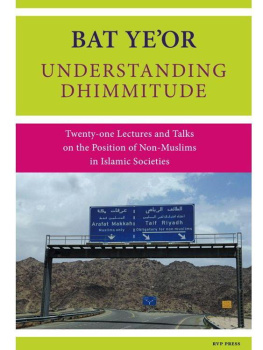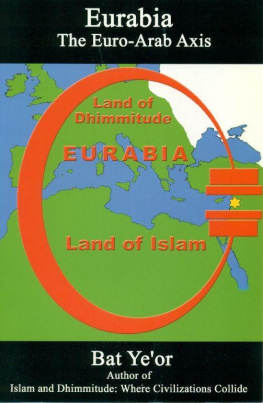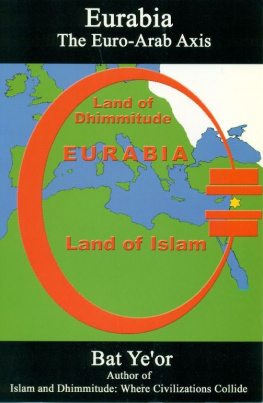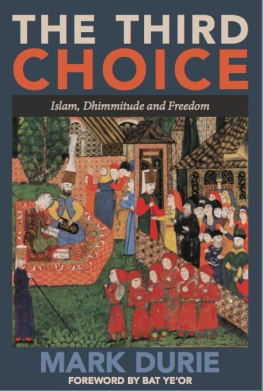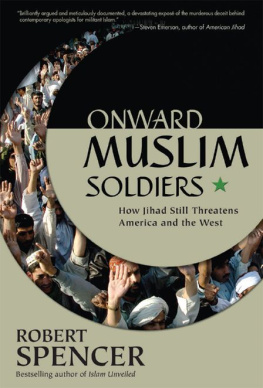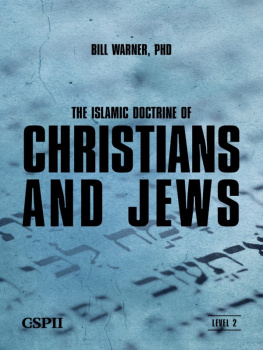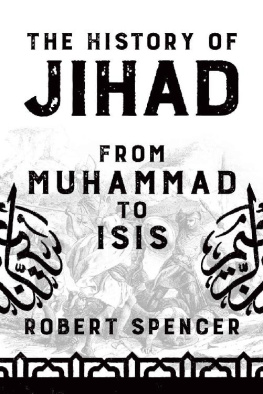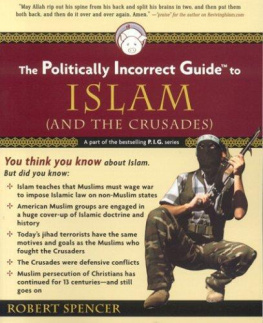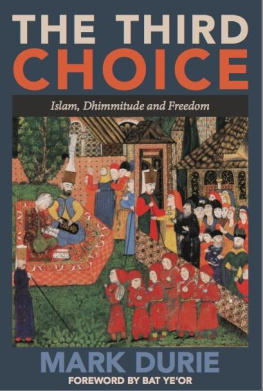Table of Contents
Dedication
Preface
Conceded Toleration Must Give Way to the Acceptance of Equality
The Jewish Problematic in the Context of Dhimmitude
Christians and Jews under Islam and the Actualization of History
The Obfuscation of History
Christians and Jews: The Forbidden History
Aspects of Islamic Religious Tolerance
Christians and Jews under Islam: A Specific Condition
Jews under Arab-Muslim Rule: Past and Present
The Ambiguity of Justice in the Context of Dhimmitude
A Proposed Definition of Dhimmitude
Dhimmitude versus Tolerance: Two Conflicting Concepts
Jihad and Dhimmitude: Challenges for the Future
Dhimmitude: A Painful Process of Self-Destruction
The Decline of Eastern Christian Communities in the Modern Middle East
Past Is PrologueLessons of History: The Challenge of Islamism Today
Who Is Imposing Censorship?
Persecution of Jews and Christians: Testimony vs. Silence
Are Freedom and Security Privileges to Be Bought from a Worldwide Jihad?
Contemporary Arab and Muslim Perceptions of the Other
Political Philosophies: Ethnic, Historical, and Ideological Forces Bearing on the Holy Land
Dhimmitude as an Issue of World Policy and Human History
Letters Explaining Dhimmitudes Characteristics
Letter to Mr. David Botsford
Letter to Mr. Colin Chapman
Letter to Mr. John Wilkins
Letter to The Tablet
Letter to W.
Praise for Understanding Dhimmitude
Colophon
BAT YE OR
Understanding Dhimmitude
Twenty-one Lectures and Talks on the Position of Non-Muslims in Islamic Societies
RVP Press
New York
Dedication
This book encapsulates more than thirty years of struggle and fights together with my husband David Gerald Littman. It is dedicated to his memory and his courageous engagement on behalf of voiceless victims of oppression and prejudice.
Preface
The idea to publish a small selection of my lectures given to an English-speaking public came while my husband David Gerald Littman and I were sorting out our archives. It was a few months before his death. The long, snowy, and freezing winter of 20112012 kept us close to the chimney fire I was lighting every night. There in the library, gazing at the lake of Geneva and listening to classical music, we were sifting through tons of documents, reminiscences of our past.
They evoked the heroic years of our youth, devoted to lecturing and writing on a totally neglected subject: Jewish refugees from the Arab world. Co-founders in 1970 of the Geneva Centre dInformation et de Documentation sur le Moyen Orient (CID), we published material on this issue and gave successful interviews in Rome. In 1975, we became involved in the World Organization of Jews from Arab Countries (WOJAC), of which I was one of the co-founders. Brilliant and fiery, David supported me and devoted his time to their cause.
In 1976, we were both invited to lecture throughout England by disoriented youth Zionist organizations, whose students had no arguments when confronted with well-organized Arab hate propaganda. Most were offspring of people who had suffered through the ordeals of World War II and were clueless regarding this new peril looming ahead. I felt empathy for the innocent youth who expected tools that would help them fight the new Judeophobia. These years were devoted to lecturing and writing books and articles.
In the 1970s, Oriental Jewry was seen by most intellectual Ashkenazim as an anti-Zionist illiterate bourgeoisie that enjoyed a good life under Islams protectionthis protection being understood as one of love and respect. Immerged in the horrors of the Shoah , Western Jewry was painfully recovering from the most dreadful inhuman tragedy. Working in the shadow of the Shoah, I realized that my research couldnt interest people so deeply harmed. On the Israeli side, politicians opposed any ideas that would endanger the harmonious relationships they hoped to establish with their Muslim neighbors. Yet I had to give, in spite of my inner resistance, a call to awareness of a second Shoah , looming on the horizon. Correcting the rosy historical illusions was an ethical duty, whatever the price might be.
In this context my first articles and publications raised the hostility of Jews and Israelis. In those years a profound contempt prevailed in most Ashkenazi milieus against Oriental Jewry. The established Ashkenazi historical doctrine stated that Zionism flourished only among Western Jewry and that antisemitism existed only in Christian lands but not among Muslims. Praising Muslim benign tolerance toward religious minorities, my opponents denied my descriptions of 1) Zionism among Egyptian Jews and in general among Oriental Jewry; and 2) Judeophobia in Islamic lands.
Now, looking back, Im able to put in context the prejudices and political motivations behind the fierce objections and personal animosity I encountered. I recognize that my attitude was like waving a red flag in front of a bull. First: there was my pseudonym, which I maintained in spite of it being ridiculed. Second: in the 1970s, I wrote articles on Zionism in Islamic lands and the persecution and exodus of Oriental Jewryall perceived as a provocation made by an illiterate Oriental Jewess.
Jewish refugees from Arab countries had dispersed throughout Europe and did settle in Israel. WOJAC conferences and activities gathered the most motivated among them. Many devoted Ashkenazim like my husband David, Martin Gilbert (later Sir), and others joined our battle for recognition. They organized, mainly in England, lecture tours for Jewish students and members of the Jewish community. Soon pro-Israel Christians brought us their support.
I didnt purposely go toward Christians. They came to me, once I had met them on the unexpected historical paths my research took me. Their tragic history gave me insomnia as I was reading it late at night, and writing it in the dawning morning. Working on my bookswith their quality and errorsand trying to approach as near as possible their human reality, was for me a moral discipline to discern truth.
Christians contacted me in the 1970s and invited me to lecture, introducing me to milieus I wouldnt have encountered otherwise. Over the years we became friends, as I witnessed their struggle against the general ignorance on this subject among Western Christians, with often revolting prejudices against them. I was happy to help them whenever I could. However it was not always easy to work as a Jewess among Christians, since poisonous arrows could angrily be thrown at me by opponents. Antisemites were enraged by Jews devoid of hate toward Christians.
My Christian friends were very open to Jews and Israel, adhering to the biblical roots of Christianity. We hoped that, united, we would bring Muslims along the way to reform. In the course of my lectures, I also met young, bright, and open-minded Muslims. I saw them as the very agents who would reform their people, leading them out of the shackles of religious hatred. I dreamed of a peaceful world where the lamb would sleep next to the lion.
Working with Christians widened my horizon, cleansed me from intolerance and prejudices and enriched my knowledge with the discovery of their own dhimmi history so close to the Jewish one. I delighted spending days in the endless diplomatic archives of the Foreign Office; or reading fourteenth-century Byzantine writers, quietly sleeping in the dust of the London Library. By the eighties I could foresee Europes transformations; I was feeling like a woken person moving among the blind.
David and I were privileged to participate at the First National Conference on the Persecuted Church (March 2627, 1998), at the First Baptist Church, Columbia, SC, under the title Shattering the Silence. It was sponsored by Evangelism Inc. and several other Christian organizations and churches. The next day, on March 28, 1998, we both gave a lecture at the Conference on Human Rights of Religious Minorities Worldwide in the auditorium of the Faculty of Law, South Carolina University, Columbia, SC. The Muslim audience there was quiet, polite, and open-minded. They were all of African origin, the women unveiled and dressed in beautiful, traditional, and colorful attire. I guessed they knew nearly nothing about dhimmitude and seeing them so pretty in front of me, I somewhat diluted my speech. My husband David was a very tall, strong, and fiery man. Im the opposite: a small woman, fragile, shy, and often afraid. It is David who threw me in the battlefield, forcing me to lecture in public, to answer questions thrown at me from right, left, and center, attacking back, and emerging from such disputations as if I was groggy.
Next page
